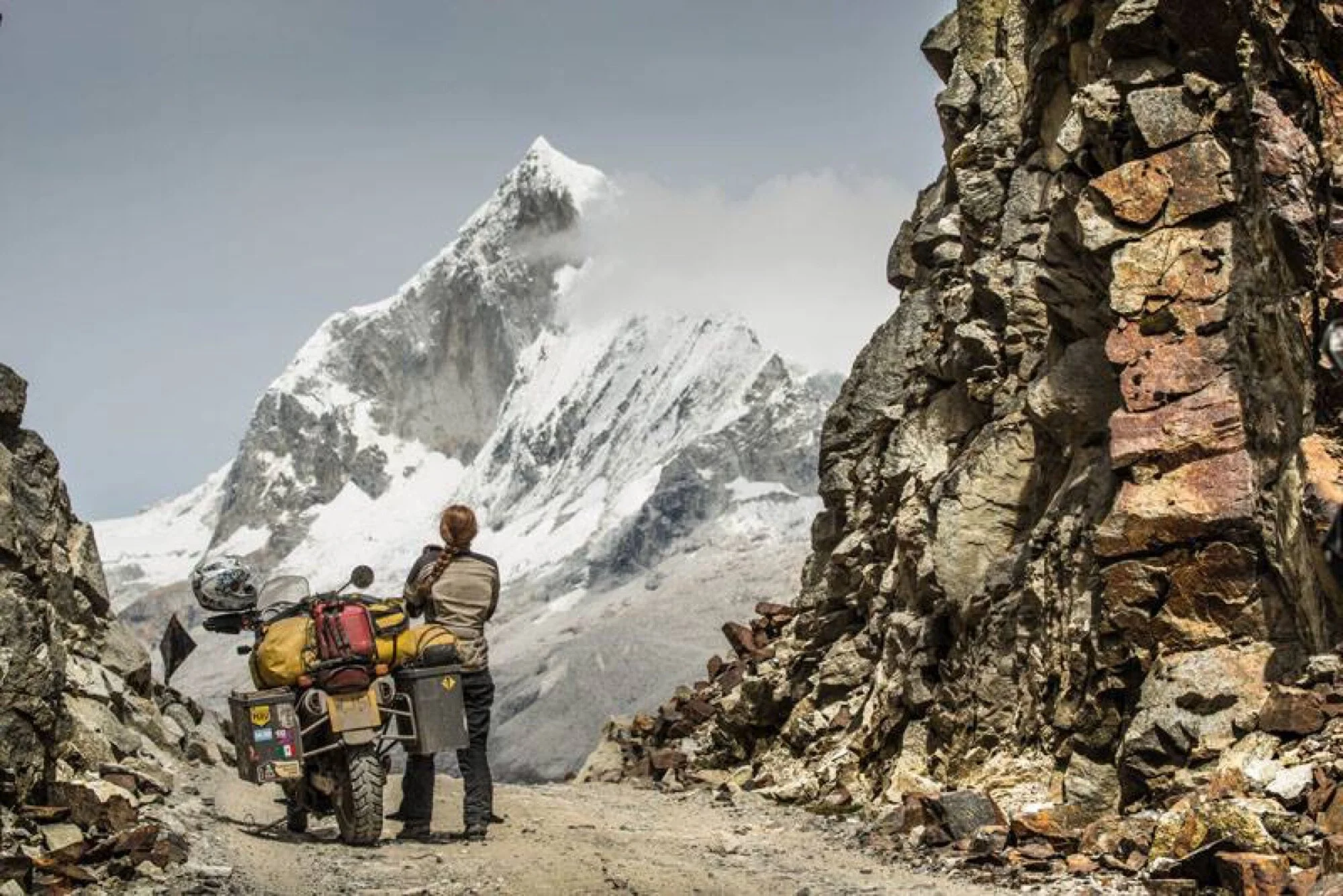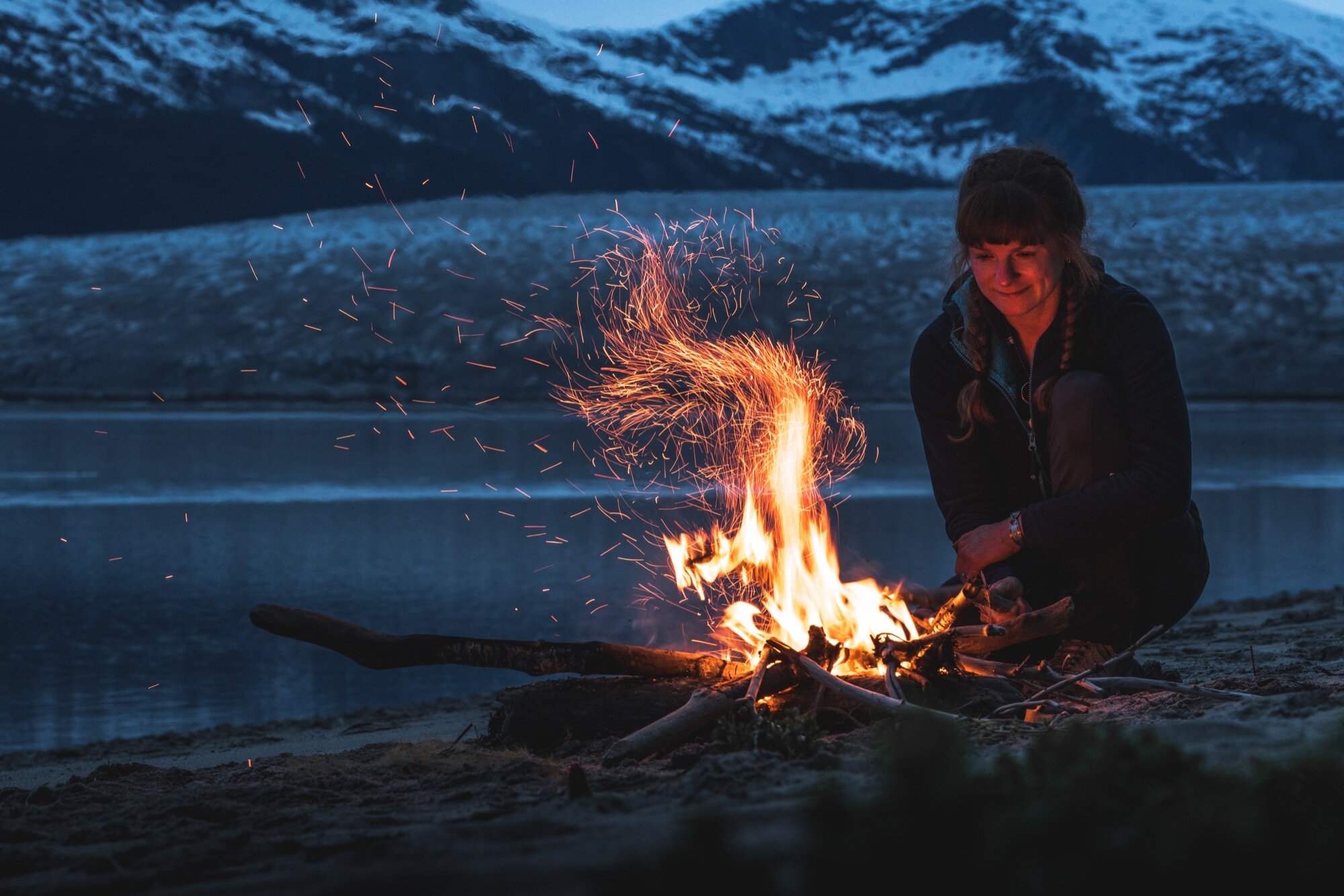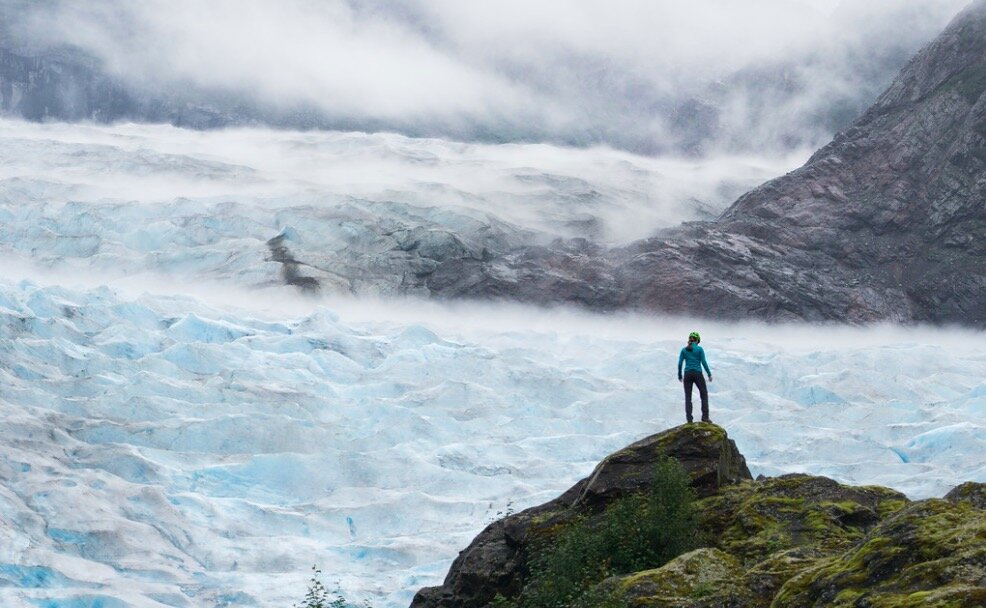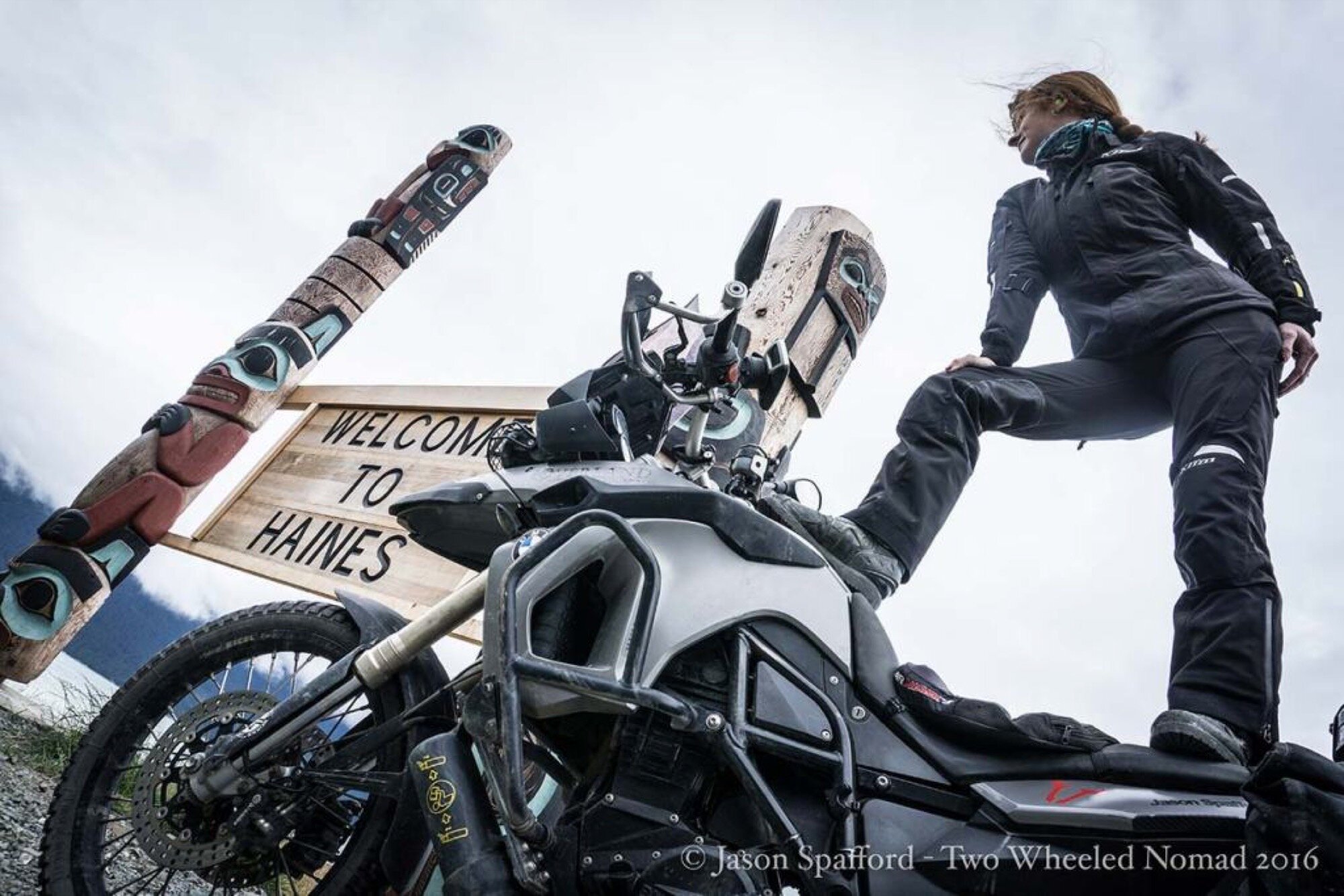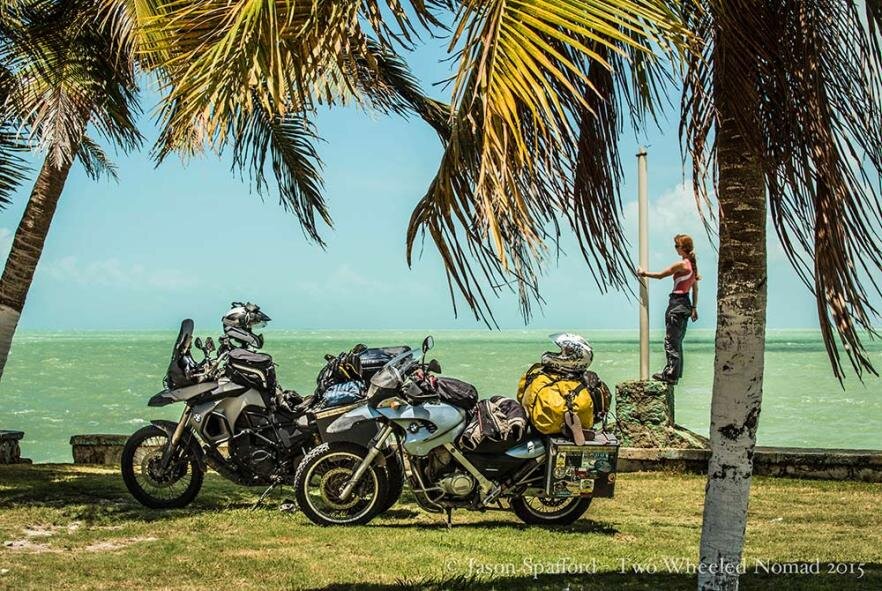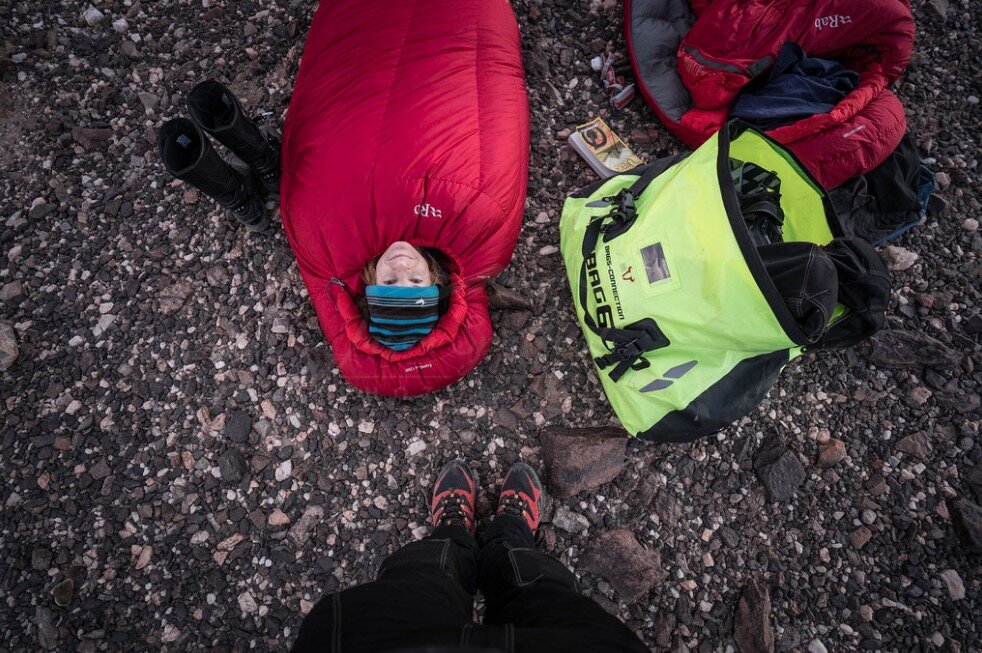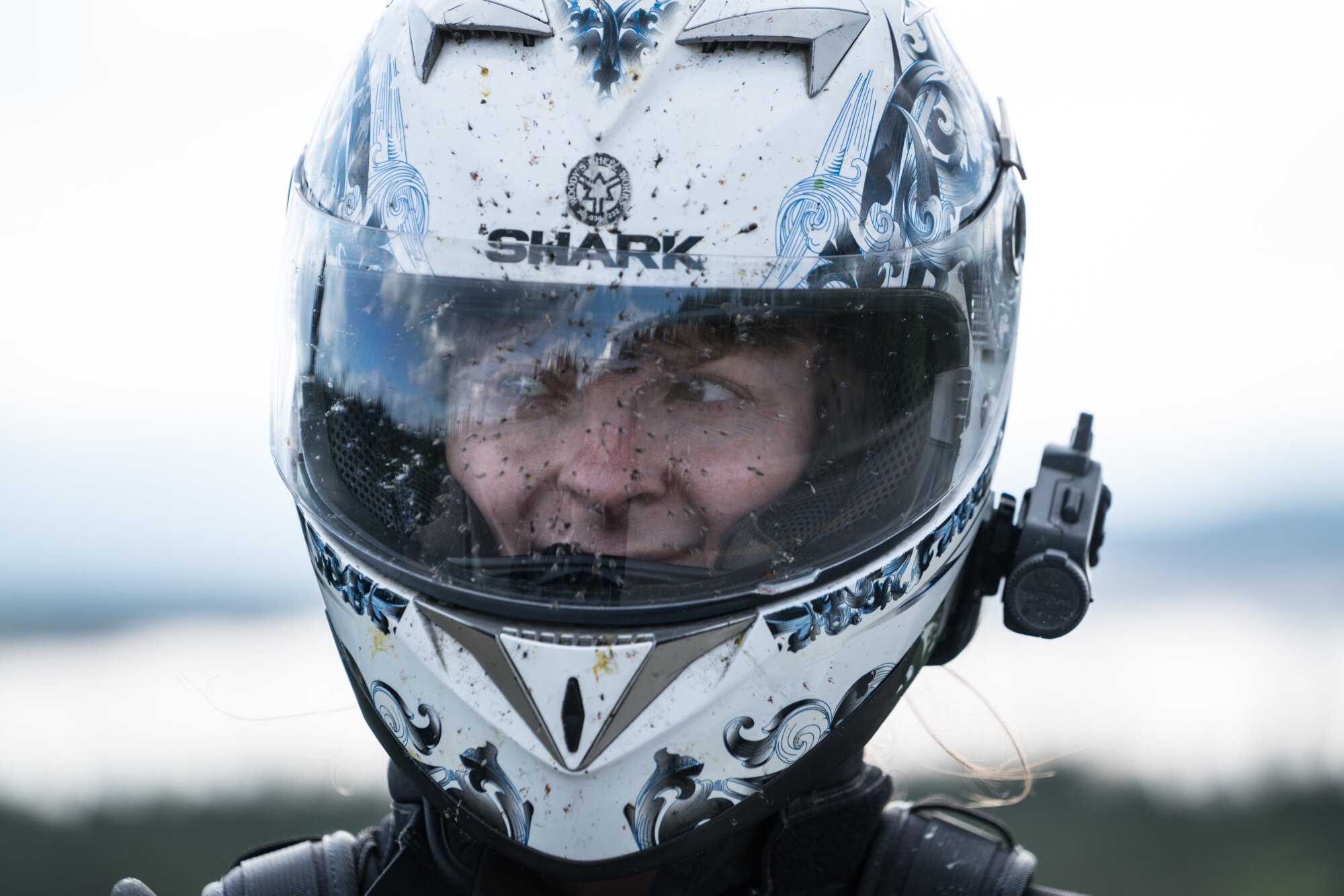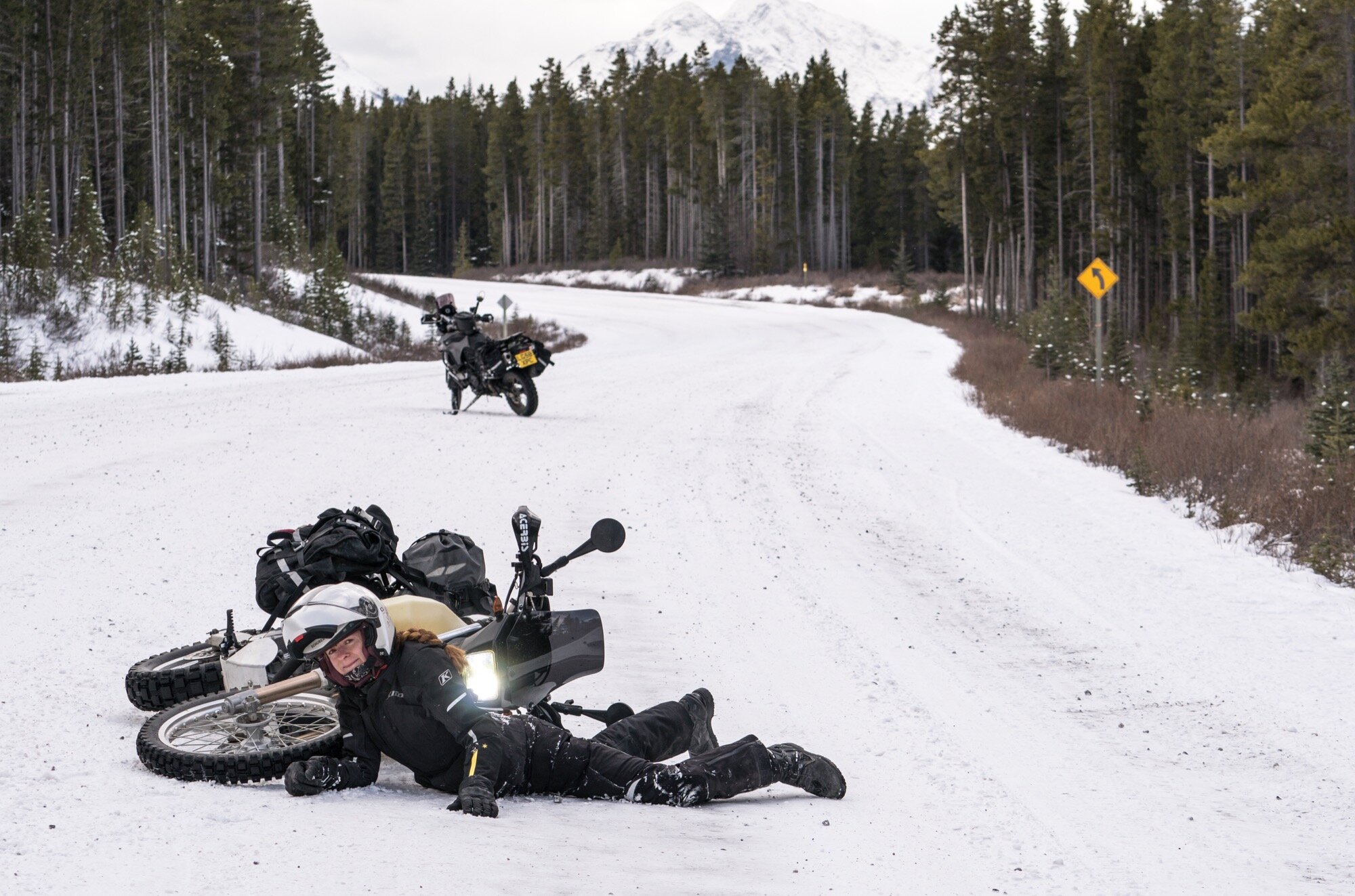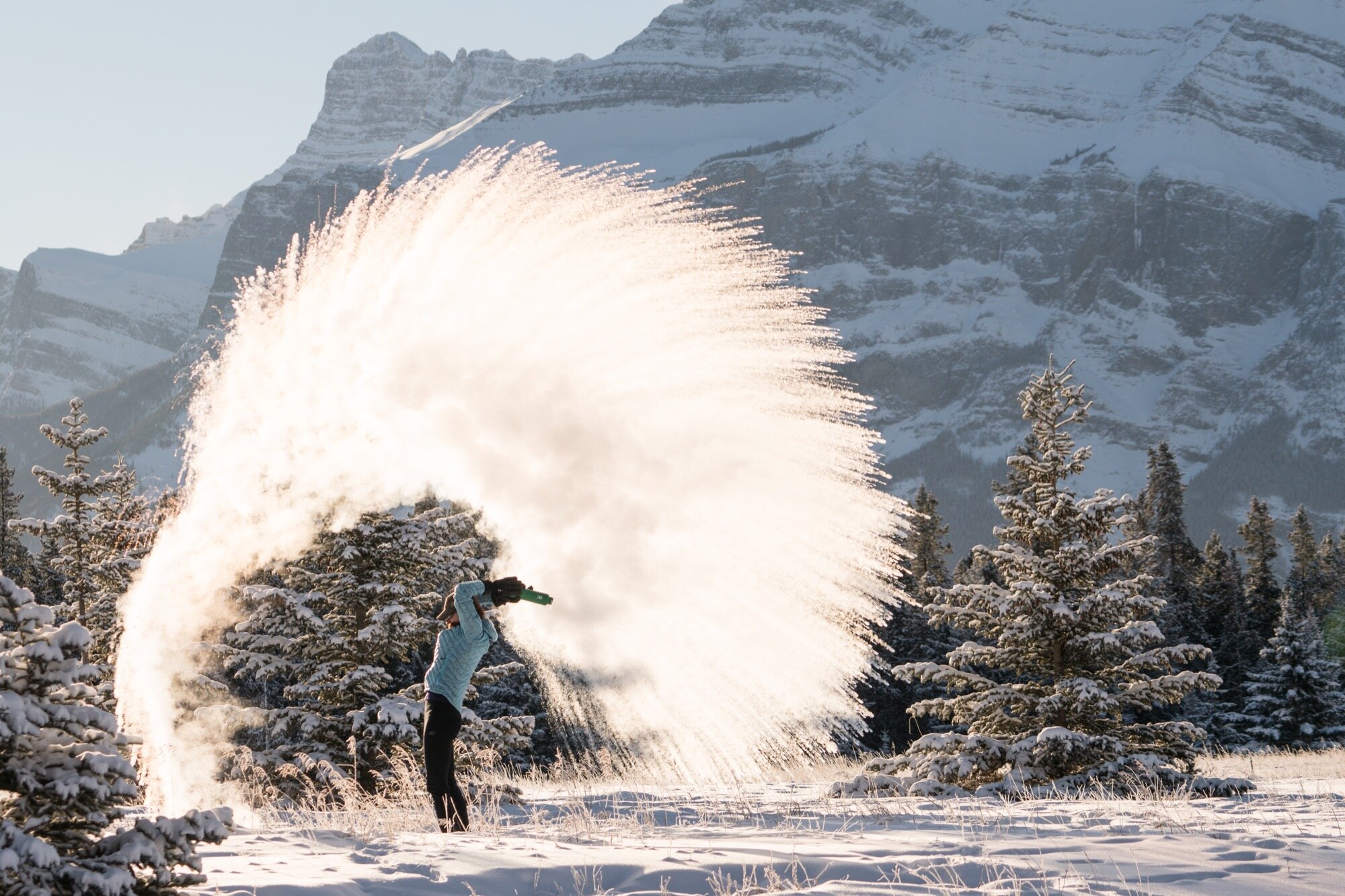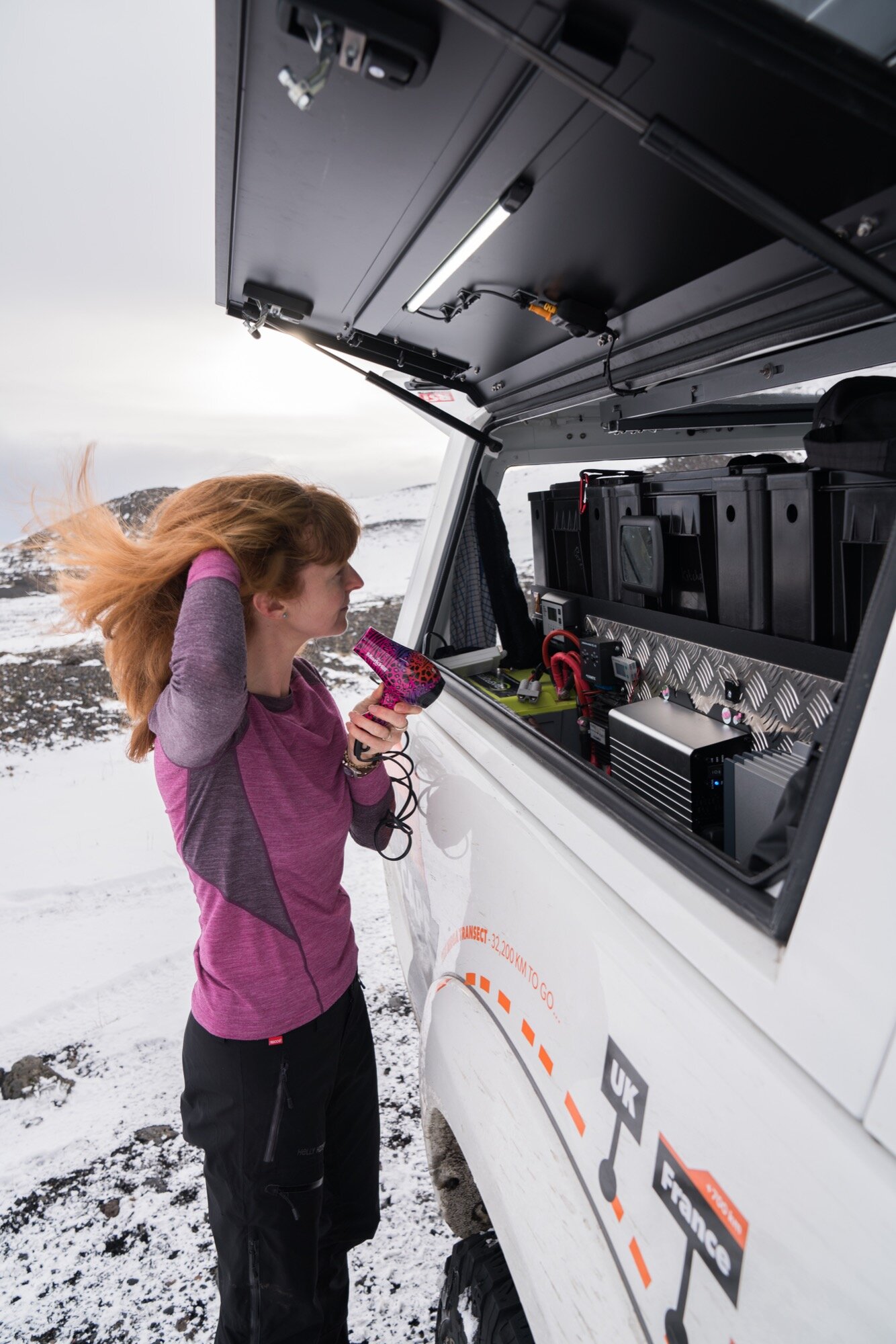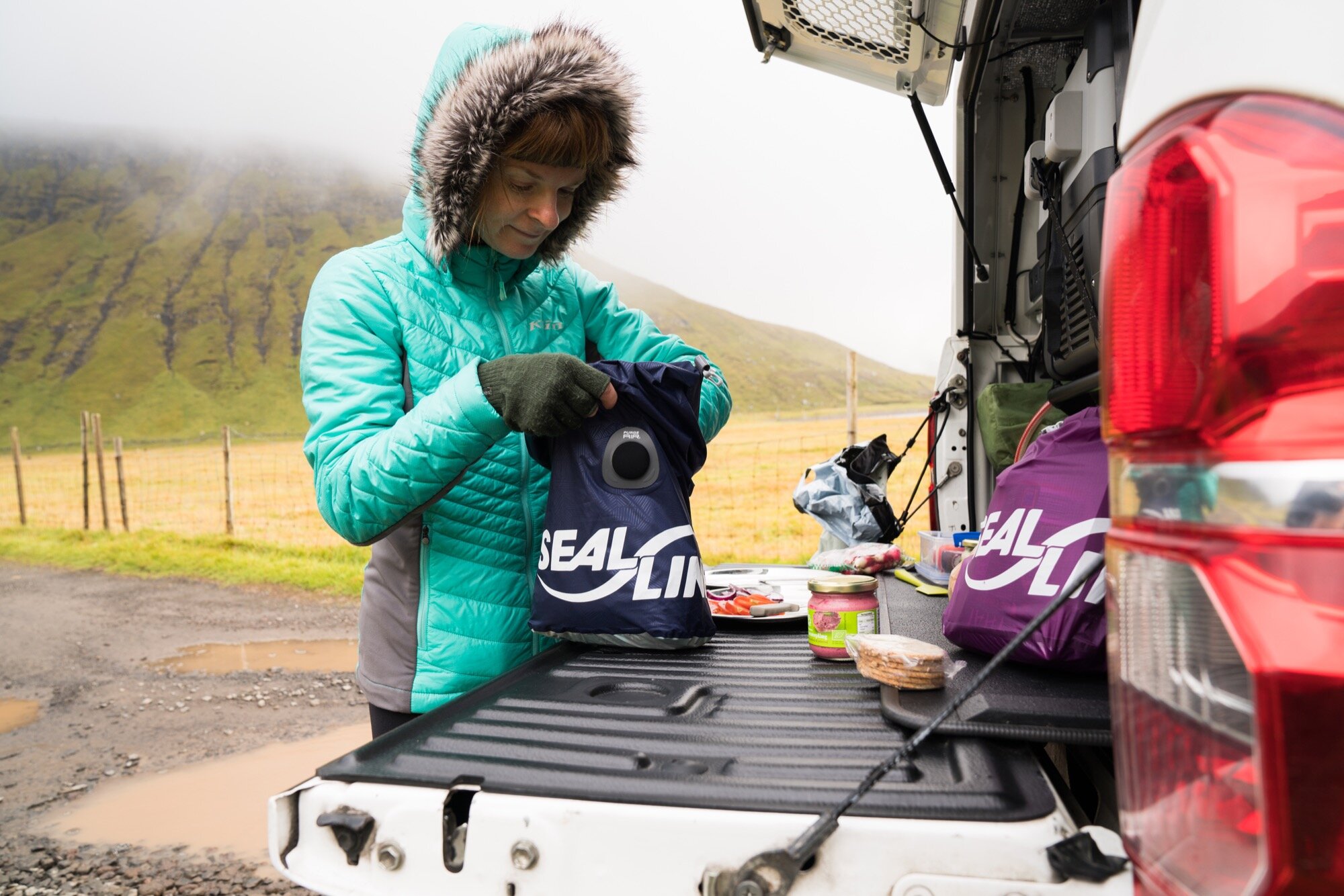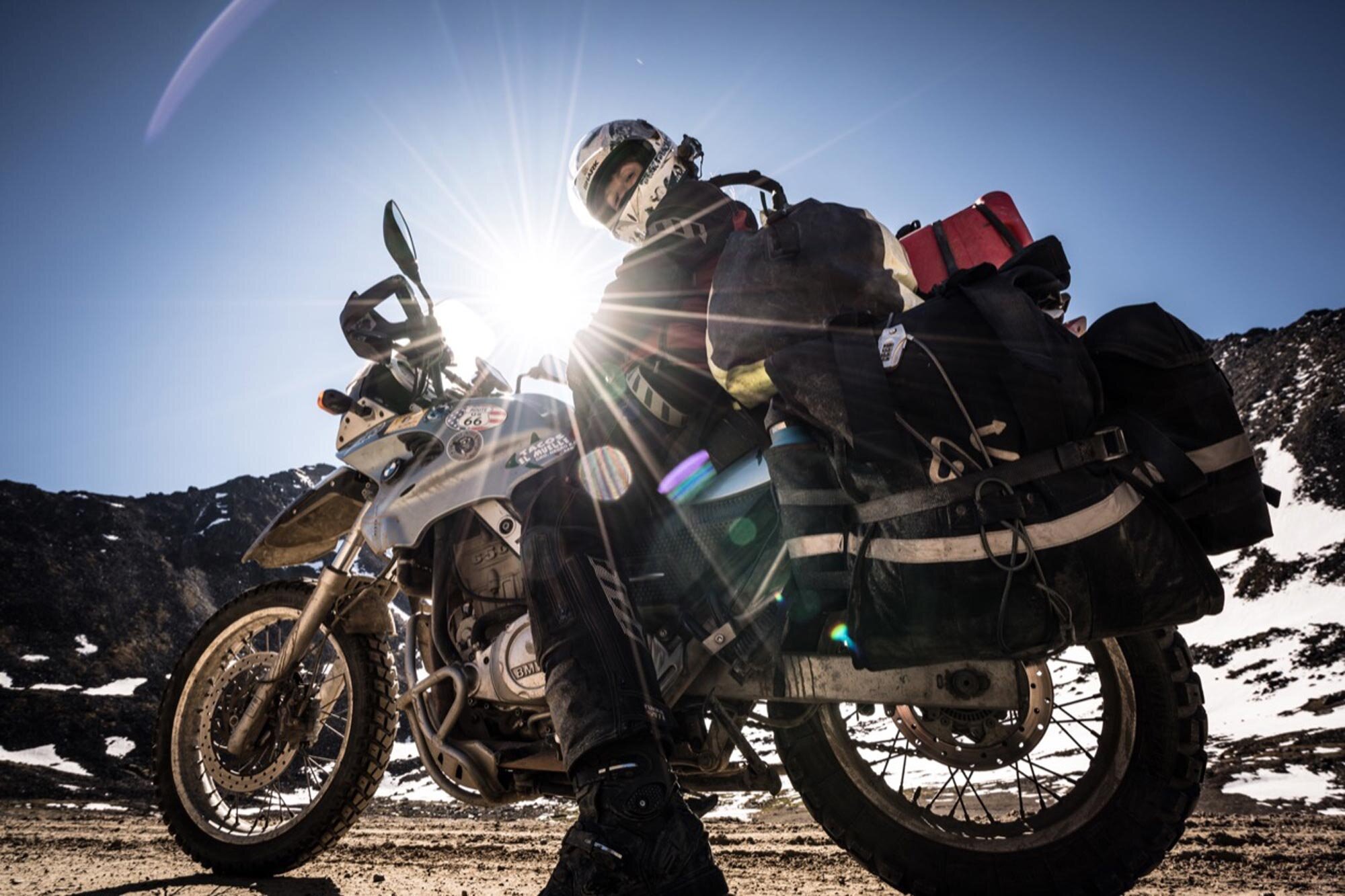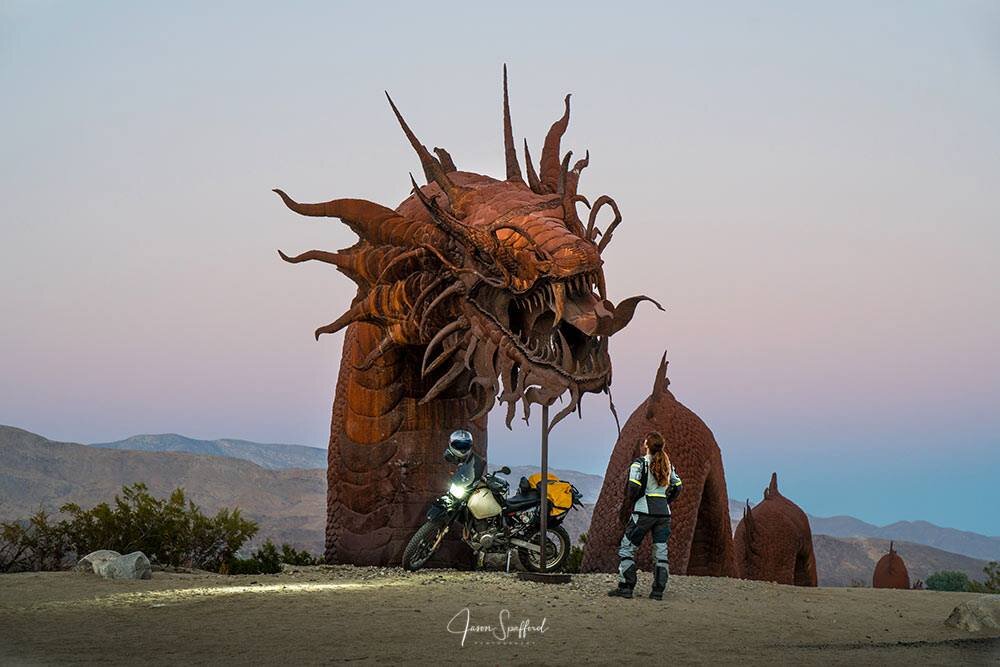Feature: Lisa from Four Wheeled Nomad
“Each research session makes the trip look harder and harder, so we’ve decided to stop researching.”
Hello there! British born, I’m Lisa Morris and my fella is Jason Spafford, we’re self-proclaimed wilderness-seekers at Four Wheeled Nomad. Remote exploration is the driving force, enabling our skillset as content creators. After combining our love for diving and photography since childhood, during a decade of experiencing the world below the waterline, a change was eventually overdue.
With a lifelong passion for taking pictures still in focus, we hung up the fins and decided on a big one. Long story long, sold our cottage in the country, pared down possessions to a few boxes, and packed what we thought we’d need on two dual sport bikes to take in Antarctica to the top of Alaska. We’ve lived a few trips, but this one took the prize – a life-changing adventure ensued lasting over four years.
Jason’s beautiful captures of terrain less trammelled can be found on Instagram. Equally in need of a creative outlet, I freelance for publications worldwide with tales from the trails in the hopes of inspiring people to consider their relationship with nature. Currently, a Cape-to-Cape expedition we’re calling The Mega Transect from Northern Norway to South Africa sees us in White Rhino, our Toyota Hilux house-on-wheels.
Who or what inspired you to choose independent vehicle travel as your mode of transportation?
We never defined success by our income or our postcode, and neither of us seemed cut out for domesticity, so we decided to live our life on the road. We didn’t have children and we weren’t married, so why not swap the life conventional for the ride of a lifetime. I bought Pearl, a factory-lowered ‘01 BMW F650GS found on eBay, because I liked the color. It matched my helmet, much to Jason’s exasperation. Amusingly, Jason used my bike as our pack mule and saved his ’08 BMW F800GS for “tech” as he calls it – a camera, its lenses, and a drone. “If I want to be better wife material, this is how I do it”, I thought as we rode onto the container ship destined for Uruguay.
Why then, did we merge two pairs of motorcycle tyres into a set of all-terrain, snow-worthy rubber? In truth, we chewed the fat for some time before answering that one. Empowered as I became, occasionally the rub of motorcycle travel would take its toll. Upon reaching a trailhead in the mountains for instance, we’d often crave a day off to go trekking or a burst of through-hiking. Specifically, give ourselves a break from munching hundreds of miles to get there. Although rarely is there anywhere in far-flung places to secure your gear and valuables, let alone the precious steeds. Nor did we have the capacity to carry enough provisions to stay off-grid much beyond 48 hours and thus, had to forego sinking into those faraway places.
Motorcycle limitations notwithstanding, travelling has always been transformative; riding the Americas – from the southern tip of Argentina to the northernmost navigable road in Alaska – was pure frontier. As tempting as jumping back in the saddle was, the time came to embrace a solution that would eliminate the inherent pitfalls of motorcycle travel. Foremost allow us to reach and encounter isolated wildernesses through all the seasons safely.
Everyone always asks a traveller what their favorite country is. Do you have a favorite place?
Continent: Antarctica. Country: Argentina. Island country: Iceland. State: Alaska. City: Antigua, Guatemala. Village: Iruya, Argentina.
Overlanding sucks sometimes because…
…you can’t be in two places at once. Traveller’s guilt can kick-in during special moments in your family and friends’ lives, you tend to miss out on the minutiae as well. Still, it makes the reunions all the more sweet and meaningful. On another note, constant companionship is the best and worst thing about long-distance travel. Even though you love your partner, there’s only one person to listen to your frustrations, which typically involve them. If I had a pound for every time I swallowed the words: "Come on Captain Slow, give it some beans!” Thankfully, we're not grudge-bearers, but heaven forbid one of us got hangry. My winning strategy boils down to this: don’t nag the guy. Sometimes he wears the trousers, sometimes I do.
I am a badass woman because…
Ahem, I suppose because I learned to ride a motorcycle shortly before riding Pearl from the bottom of the planet to the top. Minimal ride time under my belt necessitated a giant leap of faith into the unknown. Not exactly a natural rider, I learned heuristically while doing my utmost not to wrap myself around a lamppost, wind up in a ditch or wheelie my bike into a catastrophic catapult. One of those three happened, routinely! Indeed, the challenge to blindly trust my steed in the soft stuff incurred countless “offys” at slow-speed. As was having the confidence to take Jason’s sage advice and control at the reins. This was a bone of contention for him, which led to some initial discomfort, but such is life on the road when your riding skills differ. You get back on your bikes, and you ride it out together because you need to, and you want to.
Magically, the bikes defined the trip, what we yearned for, who we were. It’s the gruelling satisfaction of big distance riding that made the journey hard but euphoric – the hard is what makes it so great. Throughout long, beautiful days in the saddle, I adored how the motorcycles magnetised people to us. You make contact, share, learn, and grow. It’s integral to what makes me happy.
What is your favorite quote?
Someone wizened said “Each research session makes the trip look harder and harder, so we’ve decided to stop researching,” which is a gem to keep in the back of your mind. Particularly if you find yourself waist-deep in pre-trip planning activities and start feeling increasingly anxious. Is it better to throw caution to the wind and just go where the road takes you, or to indulge a bulletproof itinerary? Organising your first big adventure can feel like a daunting task. There is much to consider and even more to research.
Chris Scott’s Adventure Motorcycling Handbook or Overlanders' Handbook: Worldwide Route & Planning Guide: Car, 4WD, Van, Truck are solid starting points. We got away with doing the bare minimum because the Americas is such an easy set of continents through which to travel. Central Asia for example may well prescribe a little more homework. Doing the groundwork for your trip will unquestionably make life simpler on the road, allow you to spend less time troubling over details, and more time enjoying yourself. But don’t sweat the small stuff.
One of the most common questions we get is about finances. Do you have any tips, tricks or advice on this topic?
How does the average person afford it?
Neither of us earned silly money in our former lives. Just your standard income university-educated professional on salary and earnings as a self-employed sole trader. It sounds obvious but start saving early. At least a year, or longer if you’re not a savvy saver. It took us well over two years. And let’s face it, financial planning is one of the least appealing aspects of facilitating a life on the road. If you’re not comfortably wealthy from the outset, my advice would be to save the travel money after non-negotiable bills FIRST, not last. Cut everything else. Generally, there are five solutions to making a big trip financially manageable: cheaper living; selling stuff (no one regrets a good de-clutter and it’s less to keep in storage); earning more (getting a pay-rise or a second job); cheaper travelling or pushing your trip’s start date back.
Consciously living below your means is really all it takes. A tried and tested method of this is to live as though you’re on a starting salary, banking the rest into a separate account. People on minimum wage cope on their earnings, why can’t you? Similarly, if your respective other is joining you on the trip, why not both survive solely on one income and save every penny from the other person’s. More about the basics of financing the trip: here.
How has this experience changed you?
During our Americas trip, I decided against having a kid, which surprised the heck out of Jason. Fortunately, we want to see where an unscripted future takes us. Though after 16 years of being together, I got tired of waiting for him to propose, so on a leap year while watching grey whales in Mexico, I popped the question. He said yes. The current Cape-to-Cape overlanding has consolidated the fact that we don’t wish to return to our former 9-5s.
What do you think is the biggest challenge for women overlanders? And the biggest advantage?
I won’t deny it. Such outlying spots in the cooler months gave rise to countless “suck it up” scenarios. While plugged into heated clothing astride the bike worked a charm in the chilly regions, as soon as we kicked the side stands down, the elements would get the better of me time and again. Compounded somewhat by living out of two panniers and a roll bag. Will I miss having rain-obscured vision as we make a beeline towards a bank of swollen clouds into a coming storm? Or, cruise-missile insects smacking my face at 50 mph? Leaning into raging Patagonian winds on Ruta 40 while involuntarily making the grunts of a professional tennis player? Worse still, making camp when the cold siphons all feeling from the fingers, my nose and toes so numb in an ill-wind, it gnaws skin and bone. Probably not.
On a positive note, road patrol through South and Central America frequently stopped us in our tracks. Namely, to check our paperwork, elicit a bribe or break up the boredom by wanting to unearth the entire contents of our luggage. Soon dialled into these time stealers, I learned that nothing ends a conversation quicker, than revealing one’s feminine products. Not quite used to interacting with strong, western women, the strategy in Latin America worked a treat in attaining swift dismissals for us both.
Upon being asked to pay roadside “officials” a bribe on countless occasions, gentle persistence in conveying the language barrier, or showing a stoic willingness in polite decline, kept our hard-earned pounds in our pocket. After all, we were time-rich and had all day to sing their tune. Otherwise, I asked for a receipt, which worked well. Such tactics may not work everywhere, though. Often, a friendly exchange is all that’s required.
What are your favorite overland resources (blogs, books, FB pages, etc.)?
Here are some of my favourite inspirational books and DVDs by women. See the Resources page on our website. For hunting down campsites, iOverlander and the park4night app is excellent. For locating tent space and rooms, Horizons Unlimited is the gold standard for connecting with salt-of-the-earth folks, along with Couchsurfing and EatSleepRIDE apps. For renting a room, AirBnB and MotoStays are good. Maps.Me app offers offline worldwide maps with fantastic attention to detail on the trails. Waze is an accurate 3D GPS navigation tool. Apple Maps also has incredible satellite detail off legal off-roading. The SkyCode app deciphers whole paragraphs into your desired language, and Duolingo is a priceless linguistic learning tool. The Word Lens app lets you hover your smartphone camera over foreign text, leaving you in grateful awe when it supplies the desired translation.
What simple life hacks have you discovered while on the road?
Going off-grid: Uber remote overlanding may warrant investing in a satellite communicator to send and receive texts with GPS co-ordinates worldwide (e.g. inReach), which we don’t have but are considering for Africa.
Three items we cannot live without: 1.) Our Motorhome WiFi 4G system. It gives us enhanced WiFi from the truck, even when there’s fleeting signal. Among countless reasons, we can constantly check the weather and conditions/ accessibility of roads. 2.) An external battery pack. With a photographer in tow, we utilise a PowerTraveller unit on foot, a Dometic PLB40 and a Transporter Energy battery powered by solar in the rig – all are lithium so perform well in the cold. 3.) We purify our water from natural sources using a LifeSaver 20,000 UF jerry can.
Stay dry: Anything that’s quick-dry and breathable but merino wool over cotton, and down over synthetic. Religiously change from your “wets” (the clothing in which you’re exerting) to your “drys” (a set of dry clothing to keep your core warm during rest periods).
Take a comfort break: When Mother Nature’s doing her worst, carry 1.) travel-size hot water bottles. (I throw one in my sleeping bag when temperatures become rude) 2.) A Nalgene bottle for ahem, peeing in. Ladies: Consider accompanying the process with a SHEWEE. NB: Resisting the “urge” exerts energy that could be used on your extremities when it’s cold. When nature calls, you should always answer.
Universal items: Duct tape anything that looks like it could leak, pack a multi-tool (a Leatherman Signal is our go-to), and it’s amazing what you can achieve with a needle and floss – a strong material to substitute sewing thread: pop a button back on, darn your socks and gloves, slice cheese, close holes in the tent, repair a backpack, fishing line alternative, hang items from a tree, make a clothesline…
Nothing burns like the cold: Frostbite and hypothermia are legitimate concerns while winter camping. Tucking fingers under your armpits or on a friend’s stomach are gleeful ways to warm up! Try the Swiss Army technique: Lock both arms straight and position your hands perpendicular to your arms. Assertively move both shoulders up and down, which sends blood down to your fingers.
One item I wish we’d had from the start: Your face may pleat with pity to learn that we’re in Iceland until mid-December in sub-zero temperatures without a parking heater (e.g. Webasto). It would have saved wasting pricey diesel, engine wear and exhaust emissions. We would also relish a USB/240V heater for the rooftop tent but at some point, you have to start investing the trip, not gear and equipment.
Pay it forward: Carry something to give away – you never know when you’ll need someone’s help e.g. beers, cookies, stickers…doesn’t matter – it breaks the ice and any language barriers.
Pack a big smile: An international friendly hello without having said a word. Being as approachable as humanly possible is number one when travelling through foreign lands. At borders, be the nicest and sweetest you, while keeping your answers relevant and concise.
Good to know: Find out the current exchange rate before entering a new country. Also, find out whether road insurance is mandatory or not, because in some developing countries, it’s not worth the paper it’s written on.
What advice would you give to someone with a dream to travel overland?
Five easy steps
Step 1: Set a savings goal. Make it good. Write it down: dates, times, countries, learning a new language, the Salar de Uyuni. Whatever is important to you.
Step 2: Figure out what it costs. (Getting a feel for what others spend, see financial reports on smboilerworks.com and atlasrider.com.) Admittedly, some things are easy to budget. Riding from continent to continent: not so easy to budget. The process involves number crunching and possibly a spreadsheet. Start one, build in plenty of flex. Get an idea as best as you can of what it’s going to cost in terms of: shipping / flights, gas, food, maintenance and repairs, accommodation, excursions, entry fees, insurance, borders / visas / permits, miscellaneous costs from back home, and then factor in a buffer for unforeseen or one-off expenditure. Tricky at best but you need to start somewhere. Great, now you have a ballpark figure. Ouch.
Step 3: Have a stiff drink.
Step 4: Make a plan. This is easy. Take the number of months until departure and divide by how much money you think you will require.
Step 5: Make it happen.
Travelling has taught me…
Having evolved after every trip, we prioritised our wants and needs for the next one. What matters to us is that we’re out there unearthing the planet’s natural beauty. Right now, there is nothing more appealing than staying self-reliant – come freezing one’s maracas off in the volcanic highlands, or having the mind and cobwebs blown in a wind-tortured valley. Next year, we’ll melt like a stick of warm butter under a hot-as-blazes African sun. But all other things being equal, our house-on-wheels – built more for more temperate climes – will come into its own. After loading up on gear and new aspirations, it’s time to thank White Rhino for lifting the roof off our brains in facilitating a new era: to stuff ourselves with everything an unscripted, four-wheeled life has to give.
Final thoughts
Ultimately, we’ve fallen for constantly changing horizons, whether we’re standing in a colony of Gentoo penguins on the Antarctic Peninsula, or watching humpbacks bubble-net feed beneath us, or seeing the Bonneville Salt Flats fade in our rearview mirrors. It’s an endless loop of sunrises and sunsets, of nights spent under skies ablaze with stars. Tension trickles from our bodies, leaving us as light as dandelion seeds. We thrive on adventure, endlessly rugged and a little dangerous, and share our successes and failures. We live at large, and the thrill of travelling together has made our lives tender and raw, tough but euphoric, and absolutely, inextricably linked.
For more daily inspiration, follow Women Overlanding the World on Instagram:

